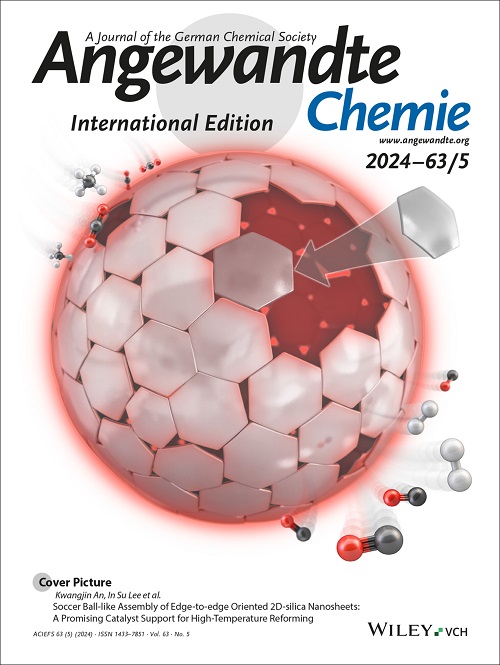嵌入型纳米铜颗粒对甲醇蒸汽重整的催化活性和稳定性显著增强
IF 16.1
1区 化学
Q1 CHEMISTRY, MULTIDISCIPLINARY
引用次数: 0
摘要
低温甲醇蒸汽重整(MSR)反应制氢在新能源开发中发挥着关键作用,但仍是一个巨大的挑战。本文报道了一种通过界面重构策略制备的Cu/Zn(Ga)Ox催化剂。有趣的是,这种催化剂具有独特的榫卯结构:Cu纳米颗粒嵌入Zn(Ga)Ox衬底中,确保了Zn- o -Cu+-Ov-Gaδ+的稳定界面结构。在225℃下,Cu/Zn(Ga)Ox催化剂的CH3OH转化率为99.3%,H2产率为124.6 μmol gcat-1 s-1,优于现有催化剂。此外,通过400 h的流在线测试,证明了超高的催化稳定性,没有明显的下降。动力学同位素分析、原位光谱表征和理论计算表明,Cu/Zn(Ga)Ox催化剂上的MSR反应遵循甲醛氧化路线。ch30 *和H2O分子以氧端吸附构型吸附在相邻的Cu+-Ov界面(本征活性位点),促进电子从Cu的d带中心转移到底物分子的O (s,p)带。这显著降低了ch30 *脱氢(速率决定步骤)和H2O解离过程中C−H键断裂的能垒,从而显著提高了H2的生成。本文章由计算机程序翻译,如有差异,请以英文原文为准。
Embedded-type Cu Nanoparticle with Largely Enhanced Catalytic Activity and Stability Towards Methanol Steam Reforming
Hydrogen production through low temperature methanol steam reforming (MSR) reaction plays a critical role in the development of new energy, but remains a great challenge. Herein, we report a Cu/Zn(Ga)Ox catalyst, which is prepared via an interface reconstruction strategy. Interestingly, this catalyst is featured with a unique mortise-and-tenon structure: Cu nanoparticles are embedded into the Zn(Ga)Ox substrate, which ensures a stable Zn-O-Cu+-Ov-Gaδ+ interface structure. The resulting Cu/Zn(Ga)Ox catalyst exhibits 99.3% CH3OH conversion with a H2 production rate of 124.6 μmol gcat-1 s-1 at 225 °C, which is preponderant to the state-of-the-art catalysts. Furthermore, an ultra-high catalytic stability was demonstrated through a 400 h stream-on-line test without obvious decline. Kinetic isotope analysis, in situ spectroscopy characterizations and theoretical calculations reveal that the MSR reaction over Cu/Zn(Ga)Ox catalyst follows formaldehyde oxidation route. The CH3O* and H2O molecule adsorb at adjacent Cu+-Ov interface (intrinsic active site) with oxygen-terminal adsorption configuration, which promotes electron transfer from d-band center of Cu to O (s,p)-band of substrate molecule. This significantly reduces the energy barrier of C−H bond cleavage in CH3O* dehydrogenation (the rate-determining step) and H2O dissociation, accounting for the extraordinarily enhanced H2 production.
求助全文
通过发布文献求助,成功后即可免费获取论文全文。
去求助
来源期刊
CiteScore
26.60
自引率
6.60%
发文量
3549
审稿时长
1.5 months
期刊介绍:
Angewandte Chemie, a journal of the German Chemical Society (GDCh), maintains a leading position among scholarly journals in general chemistry with an impressive Impact Factor of 16.6 (2022 Journal Citation Reports, Clarivate, 2023). Published weekly in a reader-friendly format, it features new articles almost every day. Established in 1887, Angewandte Chemie is a prominent chemistry journal, offering a dynamic blend of Review-type articles, Highlights, Communications, and Research Articles on a weekly basis, making it unique in the field.

 求助内容:
求助内容: 应助结果提醒方式:
应助结果提醒方式:


